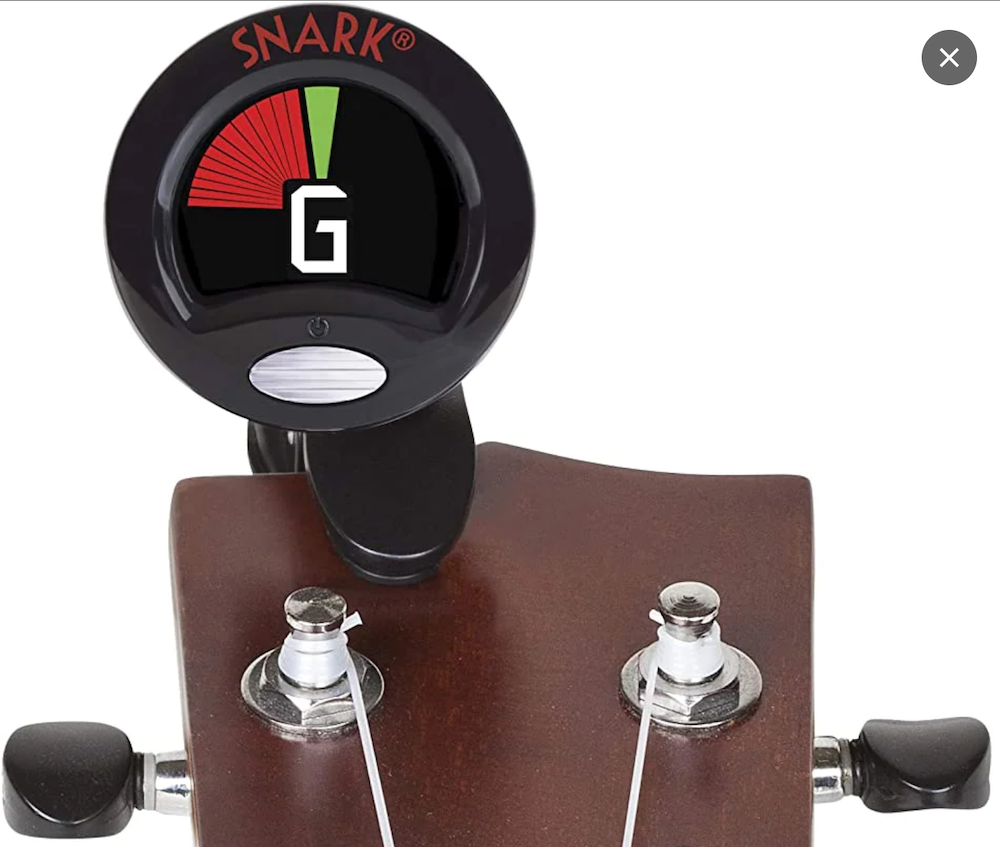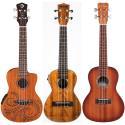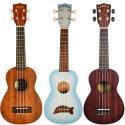How to Tune a Ukulele Like a Pro. Read This First

One of the first things every ukulele player needs to learn is how to tune a ukulele correctly.
People commonly use nylon ukulele strings, and this material is prone to detuning. Even more so when the strings are old.
So always check and set the tuning correctly before playing the ukulele, especially if you want your instrument to sound good.
Professional musicians can tune a ukulele by just using their ears.
But there are other beginner-friendly ways to achieve the correct pitch for all the strings.
In this guide, I will explain how to tune a ukulele and what tools you need for standard ukulele tuning.
Standard Ukulele Tuning
There are a myriad of tunings that you can use for your ukulele.
Some types, like the baritone ukulele, have their own tuning.
But tenor ukuleles are still the most common. So, you're more likely to encounter the tenor ukulele and its standard tuning called gCEA.
You must adopt this standard tuning to play with ukulele lessons and other ukulele players.

How to use the Ukulele Tuning Pegs
The mechanism for tuning a ukulele is similar to that of a guitar and stringed instruments.
The ukulele's strings are tied to tuning pegs on the headstock. These pegs let you tighten or loosen string tension, which affects pitch.
To raise the pitch, you gently turn the tuning pegs to tighten the strings. Loosening string tension has the opposite effect of lowering the pitch.
Changing the pitch is simple enough, but the main problem is what you set the pitch to.
And this is where tuners come in, providing a reference point for you to set the pitch of the strings.
Best Ways To Tune A Ukulele
Since not all of us have perfect pitch, we usually need a reference note for tuning.
And this is how most people tune their ukuleles. Pluck a string and match the pitch with a reference note from another instrument.
The same principle applies today, but plenty of faster and more reliable tuning options exist.
Here, we'll look at how you can tune a ukulele using tuning apps, electronic tuners, and traditional hardware tuners.
Use A Ukulele Tuner App
While there are some negatives to the widespread use of smartphones, there are positives. One of which is the ability to tune your ukulele using your phone.
Download a tuner app on your phone, and you can start tuning without buying additional gear.
A tuner app uses your phone's built-in microphone and lets you monitor your tuning on screen.
It is the most convenient of all the tuning methods and is an excellent backup in case we forget to bring an electronic tuner.
Another great advantage of tuning applications is that they work with other instruments, you can use them for guitar or bass guitar tuning, as well as mandoline, and more.
Here are some highly recommended ukulele tuner apps that are useful for ukulele tuning.
Ukulele Tuner Pocket
You can get this free tuner app on the Google App Store. This tuning app is dedicated specifically for ukes. It allows for chromatic and fine-tuning and comes with alternate ukulele tunings.
Tuner Lite
Tuner Lite turns your iPhone into a tuner with an analog tuner-style interface. It helps you tune individual strings to their exact note.
Fine Chromatic Tuner
This quick and easy tuning software works like a basic chromatic tuner for Android phones. It picks up the sound of each string and shows the pitch.
Chord!
Although Chord! promotes itself as a guitar tuning app, you can use it for various stringed instruments.
This app comes either as a free version or a paid version. I found the free online ukulele tuner sufficient for basic tuning.
Tuning Tips - Tuning A Ukulele With An Electronic Tuner

It measures your tuning via vibrations, so it works well even in loud stages and noisy environments.
It is also compact and easy to carry around for gigs. At the same time, beginners can benefit from its simplicity and reliability.
To use, clip on the tuner on the headstock, turn on the device and follow the visual prompts.
The tuner listens to the vibrations and shows on the display whether the note is too low (flat) or too high (sharp).
You can then adjust your instrument's tuning pegs to match the appropriate tuning per string.
If the note of your string is flat, gently turn the corresponding tuning peg to tighten it.
On the other hand, if the tuner indicates that the string's pitch is sharp, you need to move the tuning peg, loosening the string.
If the chromatic tuner displays a note that doesn't match the string, your tuning is too far from the correct pitch.
You must repeat the tuning process for each string until your entire instrument plays in tune.
Tune Your Ukulele With A Reference Instrument
It is always much easier to compare notes when you have an instrument to match. An electric piano is one of the easiest reference instruments since it doesn't go out of pitch.
The process is simple: turn your tuning pegs to adjust the string tension to match the pitch you're getting from your reference instrument.
Just play a G, C, E, and A on the piano keyboard one note at a time, carefully listen, and then pluck the matching strings on your instrument.
You start with the fourth string and match it with the fourth G from the left of the piano keyboard.
Continue to tune your ukulele with the third string (C), second string (E), and first string (A). They should match your piano keyboard's C, E, and A white keys.
If your piano has a sustain pedal, push it down with your foot. It will help to hold the note longer, making it easier to compare the pitches of both instruments.
This tuning method can take some time, but it is a fantastic way to train your ear and match the sounds with what you hear on your ukulele.
The downside to using reference tuning is that you need to be able to hear everything clearly. This method is not advisable for stages and environments with many sounds and noise.
This tuning method also lets you tune to 432 Hz, which is slightly lower than standard tuning.
Use A Ukulele Pitch Pipe For Tuning
Using a pitch pipe also works like a reference instrument. It only plays specific notes used for reference tuning.
So, the tuning process is similar to tuning with a piano.
A classic ukulele pitch pipe looks like a pan pipe, but it only gives you the four notes of the accompanying strings on your instrument.
This is an outdated ukulele tuning option. But it does work. Blow into the pipe opening for the string you want to check and strum the string. You can then hear if your string note is flat or sharp.
It takes a lot of work to tune to a reference sound in a busy and noisy environment.
On the other hand, a pitch pipe is smaller, so you can fit it into your pocket or case and take it out whenever needed.
Use A Tuning Fork To Tune Your Ukulele
The tuning fork is one of the oldest ways of tuning an instrument.
When you strike, this two-pronged metal tool vibrates and creates a certain pitch.
You can use it for any instrument, but a tuning fork is pitched only to one specific ukulele string.
This means you can use a tuning fork for only one string and then tune the rest by ear.
First, strike the fork with a firm but soft object. You can also tap it gently against your knee to produce the vibration.
Then, tune your instrument according to the fork pitch. Most tuning forks have an A4 pitch, standard for concert bands, orchestras, and other ensembles.
While it is impressive to see in use, it's not as practical for gigs and performances.
But in the right environment, it can be a fun tool to use and help your ears be more sensitive to the nuances of pitch.
Tuning Ukulele Strings By Ear
I put this tuning method at the end because it requires a special talent or skill set.
You can only use this method if you have perfect pitch. You can also use it if you can at least identify one pitch by ear to reference for your tuning.
You are tuning your instrument from the sound that you memorized in your head.
This is a challenging method, but it can be done, especially if you're constantly exposed to the correct pitch that you've memorized how it sounds in your head.
Tuning The Next Strings By Ear
Most musicians tend to tune just one string to a reference pitch. And they tune the other strings relative to the one string they tuned.
This is popular among guitarists and ukulele players. Here's a quick step-by-step guide on how to tune a ukulele to gCEA tuning using this standard tuning method.
Tune The C String First
Start with playing a C on a reference instrument like a piano. Or you can use a hardware or electronic tuner as your C tuning reference pitch.
Listen carefully to the reference pitch and turn the tuning peg of the C string to match the appropriate pitch.
The C string on a standard ukulele is typically the third string (from top to bottom), not the first string.
Once you establish this reference pitch, you can tune the other strings.
Tune The E Next
Next, you need to place a finger on the fourth fret of your C string.
This will play the sound your open E string should be, and you can now adjust the string with the related tuning peg. Just turn the E string's tuning peg as needed.
When I use this method, I find it helpful to play both E and middle C a few times to hear the intervals before I move on to other notes.
On a standard ukulele, the E string is the 2nd string.
Tune The G
Once you tune the C and the E on your ukulele, it is time to move on to the G. Hold down your finger on the third fret of the E string. This will produce the same pitch as the G open string.
Set the corresponding string pitch and tension, then play the G on the E string a few times for comparison.
Tune The A
The last string you need to properly tune is the bottom string A. Hold your finger on the second fret of the G string and play an A. This gives you the right pitch for adjusting your A string.
Once you have corrected the pitch, try to play the A and G a few times to hear the difference.
This technique may be complicated for beginners, but it gets easier with practice. This also helps you learn what the notes of the open strings are.
Frequently Asked Questions
Why Is The Ukulele Tuned gCEA?
Most ukuleles are tuned to High G, which is gCEA. This high-pitch tuning is considered the standard ukulele tuning. And it gives the ukulele its distinctive sound with a bright voice. Plus, G C E A tuning also makes the chord shapes simpler.
Can Temperature Affect How Often I Need To Tune My Ukulele?
Yes, humidity and temperature can impact tuning stability.
It is also essential to store your ukulele at room temperature with average humidity to ensure the instrument doesn't develop any cracks.
Do You Need To Tune A New Ukulele?
New ukuleles need to be tuned more frequently because they use nylon strings that need to be broken in.
The strings take quite a while to settle in, so you must keep tuning regularly for the first few uses. Ones broken in, the strings sound in tune more consistently.
Is A Ukulele Hard To Tune?
No, a ukulele isn't hard to tune. So many fantastic tools make ukulele tuning extremely easy, including a chromatic tuner or ukulele tuning apps.
That said, nylon ukulele strings can go out of tune quickly because they must be broken in, so you must keep up with regular tuning to proper pitch.
Is A Ukulele Tuned Like A Guitar?
No, a ukulele is tuned similarly to a banjo rather than a guitar. While they are both string instruments, the standard tuning for a ukulele is GCEA, with the fourth string tuned to the first.
Interestingly, a bass ukulele is tuned like a regular bass, following the same open string notes with the same low octave range.
Final Thoughts
Now that you know how to tune a ukulele, you can try a few options and experiment with what works best for you.
While it can be much easier to use electronic tuners or other devices for ukulele tuning, there is a true art in training your ear to hear when a single ukulele string is in proper tune.
If this article has helped you, check out our guide on the Best Ukuleles in the market.












